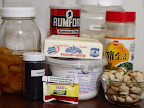Background
Tracking down information and recipes on Saudi Arabia was unexpectedly involved. Finding information on the actual menu was pretty easy, thanks to
AmericanBedu, where we learned that breakfast consists of many little dishes eaten with bread. They gave several good examples, but finding recipes for the dishes involved a trip through many books. Cookbooks dedicated to Saudi Arabia seem to be nonexistent; most of the emphasis is on Arab cuisine as a whole. Many of the books I encountered leaned toward Lebanon, but using several sources we were able to piece it together. We finally used three cookbooks to make the meal:
Arabian Delights,
The Arab Table, and the
Arab World Cookbook.
One problem with the many-small-plates concept is that there are usually only two of us for breakfast, and it's very easy to end up with much too much food. In addition to the dishes we chose, our research suggested things like ful and chickpea dishes, honey and fruit preserves, which we decided to omit in order to have a reasonable quantity for two diners.

For our meal we prepared apricots in syrup, as a compromise of honey and fruit preserves, and we made egg kebab, fried hard-boiled eggs with cinnamon and white pepper. To accompany these we had olives from the pantry, and purchased some lebna (yogurt cheese), bread, and halwa. The halwa is a sweet eaten in many places throughout the Middle East and South Asia. Today we had halwa made from sesame seeds, but it is pretty much the same idea as the soojir (semolina) halwa we made for Bangladesh.
We had intended to make the bread ourselves, but finding a recipe turned out to be impossible. A flat bread called fatir seemed really good, but the only recipe we could find called for using frozen white bread dough. The reason they gave for this was the inability to find barley wheat in the states(??). What made this recipe even more frustrating was that it has been copied verbatim all over the Internet. As we read further we learned that a wide variety breads are served, so we decided to just pick a bread when we went shopping.
We shopped at
Sevan Bakery, actually an Armenian grocery, but they had fresh bread and most of the other materials we needed. We expect to be visiting them often as we continue in the Middle East.
Our assumption going into this breakfast was that we would be drinking coffee, since coffee was discovered around Mecca. It turns out that coffee is not a breakfast drink and Saudis prefer tea instead, which is drunk from glasses.
Dried Apricots in Clove Syrup (Qamr din helw bil qurunfil)
- 1½ cups sugar
- 1 strip of lemon peel
- 2 tsp fresh lemon juice
- 11 oz dried apricots
- 1 tsp whole cloves, in a spice bag
- 1 cinnamon stick
- Mix sugar, ½ cup water, lemon peel, and lemon juice in a sauce pan.
- Dissolve sugar over medium heat.
- Add apricots, cloves, and cinnamon stick.
- Simmer the syrup for 5 minutes, or until apricots are plumped, and remove it from the heat.
- Let the mixture cool, remove cinnamon stick and cloves, and then transfer into a storage container.
Egg Kebab (Aijet Beythat)
- ¾ tsp salt
- ¾ tsp paprika
- ¾ tsp white pepper
- ¾ tsp cinnamon
- 8 hard boiled eggs
- 4 tbsp butter
- Mix the spices and set aside
- Peel the hard boiled eggs.
- Prick each egg a couple of times to release heat when frying.
- Melt the butter in a frying pan over low heat.
- Add the eggs and brown them on all sides.
- When the eggs are browned, dust them with the spices and serve.
To serve everything, we put the bread out on a platter with the various small plates on the side. The bread is eaten with the lebna which can then be topped with olive oil, olives, the eggs, or the apricots. The halwa is pretty much perfect all by itself.
Results and Discussion
This was a very nice and filling breakfast. It had a lot of parts, which can seem overwhelming, but in reality it was pretty simple. We chose to make the syrup and boil the eggs the night before to have them ready, which left only a little bit of preparation for the morning. The only tricky cooking was of the eggs, which presented a novel challenge: trying to evenly brown an egg-shaped object on a flat frying pan is pretty much impossible!
The spice mixture on the eggs tastes very familiar, with the salt and white pepper. The paprika reminds one of deviled eggs, but the cinnamon takes it in a really different direction. (I also realized a general problem that I have with hard boiled eggs: I typically eat them cold and I find the texture unpleasant. Heating the eggs improve the texture.)
The lebna is like a much smoother cream cheese, just a little more sour. It served as a lovely base for all of the other toppings.
Halwa is seriously amazing. The texture is very dense but crumbly. I would almost call it chalky but not in a dry way. The taste is a little hard to describe but it would go really well with chocolate.
(Kitty says: it tastes like the center of a peanut butter cup, only sesame instead of peanut.) Learning how to make this is high on my priority list.







